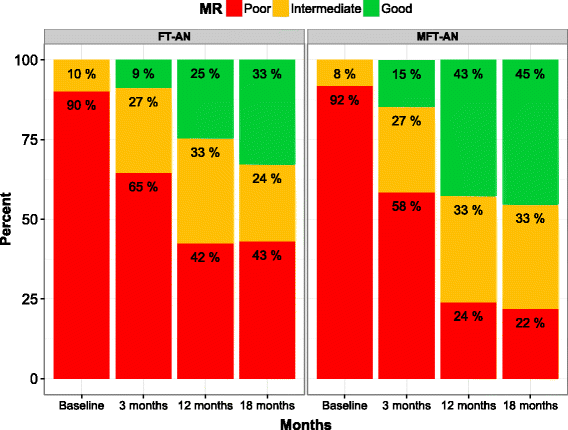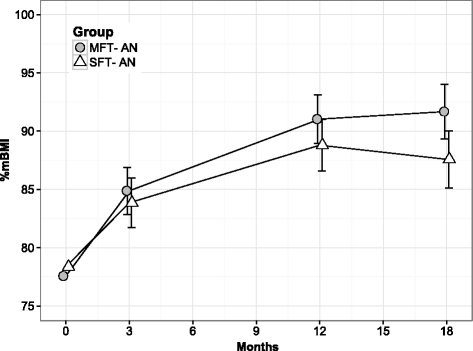A pragmatic randomised multi-centre trial of multifamily and single family therapy for adolescent anorexia nervosa
- PMID: 27881106
- PMCID: PMC5122159
- DOI: 10.1186/s12888-016-1129-6
A pragmatic randomised multi-centre trial of multifamily and single family therapy for adolescent anorexia nervosa
Abstract
Background: Considerable progress has been made in recent years in developing effective treatments for child and adolescent anorexia nervosa, with a general consensus in the field that eating disorders focussed family therapy (often referred to as Maudsley Family Therapy or Family Based Treatment) currently offers the most promising outcomes. Nevertheless, a significant number do not respond well and additional treatment developments are needed to improve outcomes. Multifamily therapy is a promising treatment that has attracted considerable interest and we report the results of the first randomised controlled trial of multifamily therapy for adolescent anorexia nervosa.
Methods: The study was a pragmatic multicentre randomised controlled superiority trial comparing two outpatient eating disorder focussed family interventions - multifamily therapy (MFT-AN) and single family therapy (FT-AN). A total of 169 adolescents with a DSM-IV diagnosis of anorexia nervosa or eating disorder not otherwise specified (restricting type) were randomised to the two treatments using computer generated blocks of random sizes to ensure balanced numbers in the trial arms. Independent assessors, blind to the allocation, completed evaluations at baseline, 3 months, 12 months (end of treatment) and 18 months.
Results: Both treatment groups showed clinically significant improvements with just under 60% achieving a good or intermediate outcome (on the Morgan-Russell scales) at the end of treatment in the FT-AN group and more than 75% in the MFT-AN group - a statistically significant benefit in favour of the multifamily intervention (OR = 2.55 95%; CI 1.17, 5.52; p = 0.019). At follow-up (18 months post baseline) there was relatively little change compared to end of treatment although the difference in primary outcome between the treatments was no longer statistically significant. Clinically significant gains in weight were accompanied by improvements in mood and eating disorder psychopathology. Approximately half the patients in FT-AN and nearly 60% of those in MFT-AN had started menstruating.
Conclusions: This study confirms previous research findings demonstrating the effectiveness of eating disorder focused family therapy and highlights the additional benefits of bringing together groups of families that maximises the use of family resources and mutual support leading to improved outcomes.
Trial registration: Current Controlled Trials ISRCTN11275465 ; Registered 29 January 2007 (retrospectively registered).
Keywords: Adolescents; Anorexia nervosa; Family therapy; Multi-family therapy; Randomised controlled trial.
Figures



Comment in
-
Multifamily therapy may add to the effectiveness of single-family therapy for adolescents with anorexia nervosa.Evid Based Ment Health. 2018 Feb;21(1):e4. doi: 10.1136/eb-2017-102732. Epub 2017 Aug 29. Evid Based Ment Health. 2018. PMID: 28851703 Free PMC article. No abstract available.
Similar articles
-
A randomised controlled multicentre trial of treatments for adolescent anorexia nervosa including assessment of cost-effectiveness and patient acceptability - the TOuCAN trial.Health Technol Assess. 2010 Mar;14(15):1-98. doi: 10.3310/hta14150. Health Technol Assess. 2010. PMID: 20334748 Clinical Trial.
-
Parent-focused treatment for adolescent anorexia nervosa: a study protocol of a randomised controlled trial.BMC Psychiatry. 2014 Apr 8;14:105. doi: 10.1186/1471-244X-14-105. BMC Psychiatry. 2014. PMID: 24712855 Free PMC article. Clinical Trial.
-
Family Therapy for Child and Adolescent Eating Disorders: A Critical Review.Fam Process. 2016 Sep;55(3):577-94. doi: 10.1111/famp.12242. Epub 2016 Aug 19. Fam Process. 2016. PMID: 27543373 Review.
-
The MOSAIC study - comparison of the Maudsley Model of Treatment for Adults with Anorexia Nervosa (MANTRA) with Specialist Supportive Clinical Management (SSCM) in outpatients with anorexia nervosa or eating disorder not otherwise specified, anorexia nervosa type: study protocol for a randomized controlled trial.Trials. 2013 May 30;14:160. doi: 10.1186/1745-6215-14-160. Trials. 2013. PMID: 23721562 Free PMC article. Clinical Trial.
-
Development and implementation of a relationship-focused outpatient multifamily program for adolescent anorexia nervosa.Fam Process. 2023 Sep;62(3):1055-1074. doi: 10.1111/famp.12826. Epub 2022 Oct 20. Fam Process. 2023. PMID: 36267018 Review.
Cited by
-
Psychotherapeutic Treatment for Anorexia Nervosa: A Systematic Review and Network Meta-Analysis.Front Psychiatry. 2018 May 1;9:158. doi: 10.3389/fpsyt.2018.00158. eCollection 2018. Front Psychiatry. 2018. PMID: 29765338 Free PMC article. Review.
-
Multifamily therapy for adolescent eating disorders: a study of the change in eating disorder symptoms from start of treatment to follow-up.J Eat Disord. 2023 Jun 7;11(1):92. doi: 10.1186/s40337-023-00814-y. J Eat Disord. 2023. PMID: 37287009 Free PMC article.
-
Are recovery stories helpful for women with eating disorders? A pilot study and commentary on future research.J Eat Disord. 2018 Aug 15;6:21. doi: 10.1186/s40337-018-0206-2. eCollection 2018. J Eat Disord. 2018. PMID: 30128153 Free PMC article.
-
Management of eating disorders for people with higher weight: clinical practice guideline.J Eat Disord. 2022 Aug 18;10(1):121. doi: 10.1186/s40337-022-00622-w. J Eat Disord. 2022. PMID: 35978344 Free PMC article.
-
Family-based Treatment of Eating Disorders: A Narrative Review.Psychiatr Clin North Am. 2019 Jun;42(2):193-204. doi: 10.1016/j.psc.2019.01.004. Epub 2019 Apr 3. Psychiatr Clin North Am. 2019. PMID: 31046922 Free PMC article. Review.
References
-
- National Institute for Clinical Excellence . Eating Disorders: Core Interventions in the Treatment and Management of Anorexia Nervosa, Bulimia Nervosa and Related Eating Disorders. CG9. London: NICE; 2004. - PubMed
-
- American Psychological Association . Publication manual of the American Psychological Association. Washington, D.C.: American Psychological Association; 2006.
-
- Downs K, Blow A. A substantive and methodological review of family‐based treatment for eating disorders: the last 25 years of research. J Fam Ther. 2013;35:3–28. doi: 10.1111/j.1467-6427.2011.00566.x. - DOI
Publication types
MeSH terms
Associated data
LinkOut - more resources
Full Text Sources
Other Literature Sources
Medical

